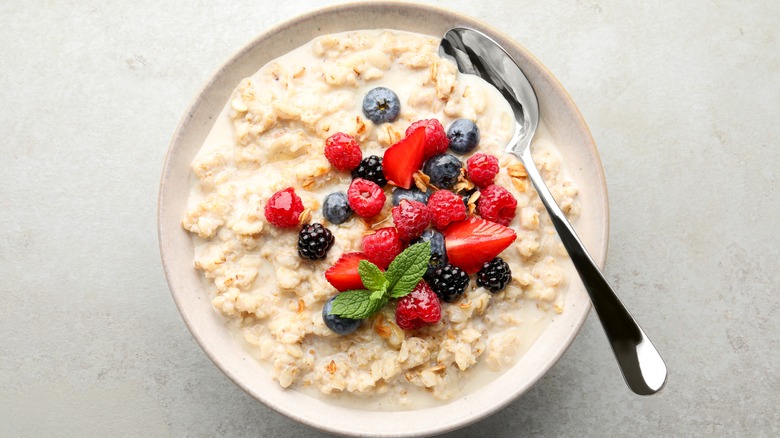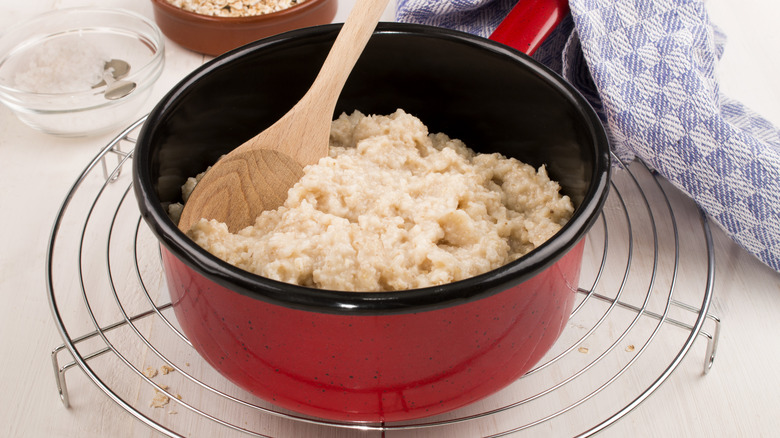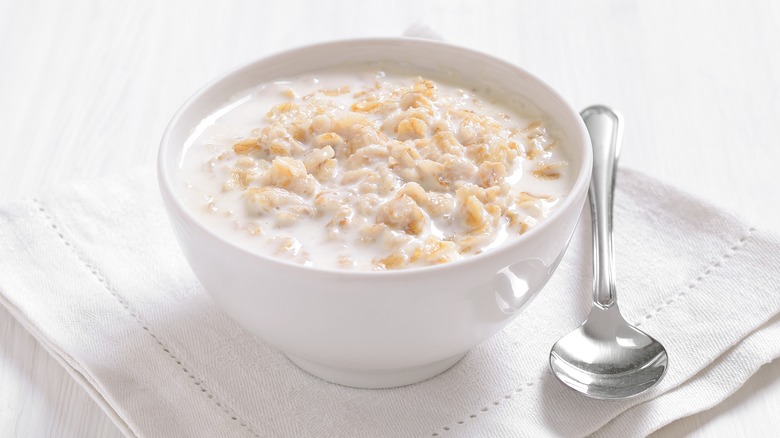Water Vs Milk: Which Is Better For Oatmeal?
Oatmeal, simple as it is, is a wholesome and healthy breakfast choice that can be surprisingly delicious when you get creative with the toppings, whether it's the classic combo of fruity apple-cinnamon spices as flavoring or even fancier fruit blends. But considering how straightforward and easy oatmeal is to make, you may be surprised to learn that there's been a pretty heavy debate on this classic recipe. Particularly, whether to cook oatmeal with water or milk!
Some people swear by cooking oatmeal with water, which is the traditional way that oatmeal porridge is prepared. It's quick and, more importantly, it's without fuss. You only need a pinch of seasoning to taste and you got breakfast ready to go. On the other hand, others like their oatmeal with milk, which (objectively!) tastes better with the added sweetness and creaminess from the dairy.
So, which one is really better? Well, you'll have to see for yourself by looking at the pros and cons of each oatmeal prepping method.
The case for water in cooking oatmeal
Lots of people cook oatmeal by simply adding water into a bowl of rolled oats and microwaving it for somewhere between 30 seconds and a few minutes. This method is easy, fast, and you don't have to bother with restocking your fridge with milk — it's not at all surprising that this way of preparing oatmeal is popular. But there are other advantages to using water to cook your oatmeal. For instance, with a pinch of salt added, it really brings out the natural nutty flavor of the oats! If you appreciate the pure taste of oats without the creaminess or dairy notes that milk adds, cooking them in water is the way to go. Water-boiled oatmeal is also the go-to method for those following a vegan or lactose-free diet.
However, this simplicity can also be a drawback. Oatmeal cooked with water lacks the richness and creamy texture you get when using milk. This can result in a somewhat "gummy" texture that not everyone enjoys. Plus, using water means the oatmeal will have a plain, bland taste. This isn't necessarily a bad thing, mind you. If you enjoy customizing your oatmeal with various toppings and sweeteners, using water is like starting with a blank canvas, allowing you to freely experiment with flavors however you like!
In defense of milky oatmeal
Water is a classic choice for making oatmeal, but if you're looking for a tastier option, try using milk. Milk not only gives your oats a creamy and slightly sweet taste but it also packs in extra nutrients like calcium and protein, making your breakfast even healthier. Just be aware that milky oatmeal can turn out thicker and stickier compared to water-cooked oatmeal.
However, milky oatmeal isn't a fit for everyone, especially those who are lactose intolerant or following a low-fat or vegan diet. If you're in this category but still want to give it a try, you can switch to plant-based milk alternatives like almond, coconut, or even oat milk if you want to stick with the theme. These options offer the same benefits without any of the concerns that came attached with dairy.
So, which one is superior? No clear winner here. As you can see, both methods have their pros and cons, so it mostly boils down to your personal preference. If you're torn between the two, you can always try and use both: Start by boiling the oats in water until they thicken, and then add your choice of milk (dairy or plant-based) for taste. Voila, you get a perfect bowl of oatmeal that's neither too plain-tasting or sticky, all while getting the nutrients and richness from the milk, too!


